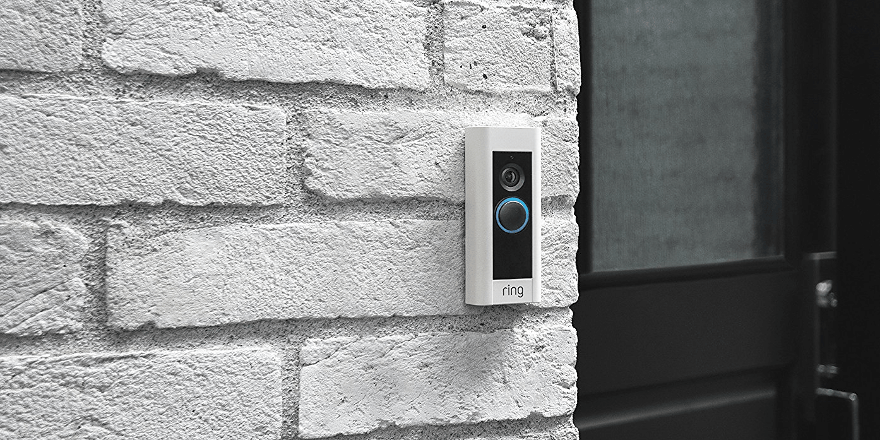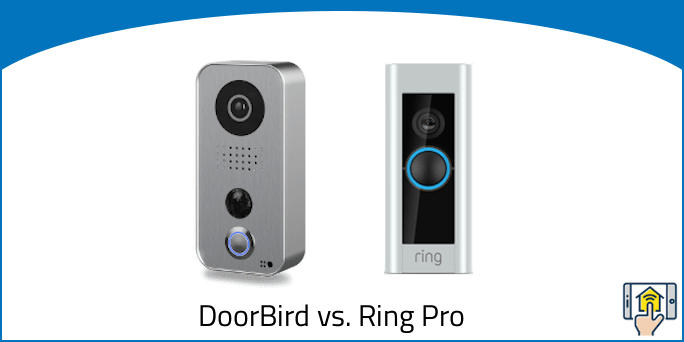Smart doorbells are a great addition to any home today.
It provides extra security with features like motion detection, night vision, as well as access to live-view on demand. While also remaining efficient by providing you with the ability to communicate with anyone via two-way audio talk.
Today we’ll be looking at Ring Pro vs. DoorBird and the benefits that each model brings.
For example, Ring’s impressive subscription plans, and the ability to set custom zones. As well as DoorBird’s impressive live-view on-demand technology, and its impressive field of view.
So let’s get right to it and see which suits your home best!
Feel free to use our navigation system to skip to any part you prefer.
DoorBird vs. Ring Pro — Things in Common
Night Vision – Luckily both DoorBird and Ring Pro have the night vision feature. Now you won’t have to worry about hearing strange noises at night, as you can check it out at any time via the live-view camera feed in HD quality!
Two-Way Audio – You can both see and communicate with any visitors via the two-way audio technology. This will come in especially handy when instructing the delivery man on where to leave your newest package, or when warning off possible thieves away from your doorstep.
Motion Detection – Keep a track of the comings and goings with the motion detection feature. If any outside activity is detected, you’ll receive an instant notification straight to your smart device both night and day. This will add an extra layer to your home security, both when you’re at home or when away.
Web App – Both DoorBird and Ring Pro allow you to access their app via your computer. This can be pretty useful whenever your smartphone isn’t on you, or when you’re already in front of the laptop.
DoorBird vs. Ring Pro — Differences

Difference #1: Power & Installation – Before purchasing your brand new smart doorbell it’s also important to check on what type of installation will be needed, so you can be prepared to set up your smart doorbell once it arrives.
Ring Pro does require to be hardwired into your existing doorbell, and you’ll also need to have a 16-24V transformer wire, as well as a power kit ready to go. It’s pretty easy to follow, and it shouldn’t take you too long to get it up and running.
While for DoorBird you’ll have two power options to choose from. You can decide to hardwire it, similarly to Ring Pro. Or go with the Power Over Ethernet option.
PoE is a networking feature that allows network cables to carry electrical power over an existing data connection, with a single Cat5e/Cat6 ethernet cable. Simply put, this power method allows the Ethernet cable that delivers internet access, to play double duty as the primary source of energy as well. Thus offering a much stronger, and more reliable connection.
For those of you who wish to skip any cables, or if you find yourself moving around a lot, it’s worth looking into a model such as Ring Peephole Cam. It runs on battery power, so it’s easy to set up as well as take off after.
No products found.
Difference #2: Subscription Plan – Having a subscription plan for you smart doorbell allows you to choose from various lengths of cloud storage, as well as other benefits.
With DoorBird you get free storage for up to 20 of the most recent visitors, including motion events. This may be enough for most users out there. However, if you wish to take advantage of even more storage you can also get a DoorBird Video Door Station or opt for a Cloud-Recording Pro.
Also for 48 USD annually, you can get an unlimited number of doorbell recordings, as well as motion sensor recordings and 7-day video storage.
While Ring comes with two subscription plans to choose from.
You have the Protect Basic, which comes with 60-day video storage, allowing you to share, and view your recordings whenever you wish. While the Protect Plus plan includes support for unlimited Ring cameras, 24/7 professional monitoring, as well as 10% off, any future Ring purchases.
The Protect Basic comes to 3 USD per month or 30 USD per year, while the Protect Plus is 10USD per month, or 100 USD annually.
For those of you who wish to avoid any subscription plan, it seems as if DoorBird could be the better option.
Difference #3: Field of View – Having a good field of view is crucial for any smart doorbell. This is where DoorBird comes out ahead with its 180 degrees Horizontal, and 90 degrees Vertical. Compared to Ring Pro’s 160 degrees Horizontal, and 100 degrees Vertical.
While both smart doorbells will give you a good view of a wide area, Those extra 20 degrees could be what will help you to identify the package thief.
Difference #4: Custom Motion Zones – Having the ability to set your own custom motion zones allows you to keep a closer eye on specific zones in your doorbell’s field of view. It could be a designated area for your deliveries, or where your car is parked. Using Ring’s custom motion zones technology, you can rest assured that you’ll be alerted whenever suspicious activity is detected.
Unfortunately, DoorBird doesn’t have this feature.
Difference #5: Alexa – Ring Pro is also compatible with Amazon Alexa for those of you who wish to integrate your Echo Show or Echo Spot. By doing so, you can use simple voice commands to operate your smart doorbell by asking it to show your live-view feed, or what time the last motion was detected.
DoorBird currently isn’t compatible with Amazon Alexa.
Difference #6: Color & Design – In terms of design, DoorBird resembles a more traditional doorbell with its stocky build of 6.18″ x 2.95″ x 1.38″. It also comes in two finishes, a light steel tone, and a white polycarbonate finish, giving it a more aesthetically pleasing look.
While Ring provides a more modern twist with its smaller measurements, it also offers 4 different interchangeable faceplates to choose from, of Venetian Bronze, Polished Brass, Antique Brass, and Satin Nickel. So you can decide on the design that suits both your taste, as well as your home.
DoorBird vs. Ring Pro — Comparison Chart
| DoorBird | ||
|---|---|---|
| Power Options | Hardwired or Power over Ethernet |
Hardwired |
| Field of View | 180 degrees Horizontal, 90 degrees Vertical |
160 degrees Horizontal, 100 degrees Vertical |
| Video Resolution | 720p HD | 1080p HD |
| Night View | Yes | Yes |
| Network | 2.4GHz, or Ethernet Network | 2.4GHz or 5GHz |
| Motion Detection | Yes | Yes |
| Custom Motion Zones | No | Yes |
| Live-View on Demand | Yes | Yes |
| Two-Way Audio | Yes | Yes |
| Web App | Yes | Yes |
| Dimensions | 6.18″ x 2.95″ x 1.38″ | 4.50″ x 1.85″ x .80″ |
| Color | Available in 2 Finishes | Comes with 4 different interchangeable faceplates |
DoorBird vs. Ring Pro — Accessories

Now that we have seen what features both smart doorbells offer, let’s check out some of the accessories that they offer too.
For Ring Pro, it’s worth looking into the Ring Chime Pro. It really takes Chime to the next level. It works as a WiFi extender, so you’ll be available to receive a strong connection all-around your property.
For DoorBird, you can also include a Door Chime too! The connection of the door chime to via the network can be made with WiFi or a network cable. The chime can also be powered efficiently via Power-over-Ethernet (PoE).
You can choose multiple ringtones for your door chime, and it can be placed easily on the ceilings or walls of your home.
DoorBird vs. Ring Pro — Our Thoughts

In the end, when it comes between DoorBird vs. Ring Pro, it can be a tough call to make.
While DoorBird does come at a significantly higher price, it also offers some pretty advanced features when it comes to your home security. Such as its impressive field of view, and the ability to place audio & video phone calls.
However, is a more affordable and a better system for those of you who want the security of multi-level protection for a better price. It is also easy to install and provides two tiers of accessible subscription plans.
Last update on 2024-04-17 at 21:50 / Affiliate links / Images from Amazon Product Advertising API


